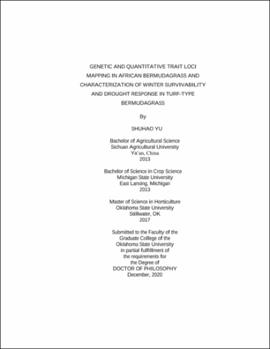| dc.contributor.advisor | Wu, Yanqi | |
| dc.contributor.author | Yu, Shuhao | |
| dc.date.accessioned | 2021-05-25T20:32:22Z | |
| dc.date.available | 2021-05-25T20:32:22Z | |
| dc.date.issued | 2020-12 | |
| dc.identifier.uri | https://hdl.handle.net/11244/329944 | |
| dc.description.abstract | African bermudagrass (Cynodon transvaalensis Burtt-Davy) is frequently used to cross with common bermudagrass (C. dactylon Pers.) in the creation of F1 hybrid cultivars that most widely used in the worldwide turf industry. The species has some unique morphological, adaptive, and reproductive characteristics that contribute to turfgrass quality improvement. However, molecular resources in this species are limited. Winterkill is a major concern for turf-type bermudagrasses (C. dactylon and C. dactylon x C. transvaalensis) when cultivated in the U.S. transition zone. Water scarcity is a widespread issue in the turf industry. It would be valuable for new cultivars to combine the two traits. Accordingly, the objectives of this study were to construct a high-density genetic map; to quantify genetic variability and to identify quantitative trait loci (QTL) associated with adaptive, morphological, and reproductive traits; to estimate reliability for spring greenup and drought response in turf-type bermudagrass selections. A high-density linkage map for African bermudagrass was constructed using a genotyping-by-sequencing approach based on 109 S1 progeny of the African bermudagrass genotype 'OKC1163'. A total of 1,278 markers were integrated in the map with nine linkage groups, spanning 882.3 cM. Establishment rate, winter survivability traits, drought response, plant height, leaf blade width and length, stem internode diameter and length, and inflorescence prolificacy in the S1 population with the parent were evaluated in a replicated field trial over three seasons (2018 to 2020) in Stillwater, OK. Thirty-six QTL were identified to be associated with the respective traits. In another experiment, 77 selections and seven cultivars were evaluated for spring greenup and drought response at Goodwell, OK. The reliability estimates for drought response ranged from low to moderate (0.20 ≤ i2 ≤ 0.63) and the estimates for spring greenup were low (0.08 ≤ i2 ≤ 0.27), indicating that winter survivability and drought resistance may be evaluated in separate trials. The research developed important genetic resources for understanding the genetic structure of the traits and towards marker-assisted selection, and added useful information to the knowledge pool for improving the important traits in breeding turf bermudagrass cultivars. | |
| dc.format | application/pdf | |
| dc.language | en_US | |
| dc.rights | Copyright is held by the author who has granted the Oklahoma State University Library the non-exclusive right to share this material in its institutional repository. Contact Digital Library Services at lib-dls@okstate.edu or 405-744-9161 for the permission policy on the use, reproduction or distribution of this material. | |
| dc.title | Genetic and quantitative trait loci mapping in African bermudagrass and characterization of winter survivability and drought response in turf-type bermudagrass | |
| dc.contributor.committeeMember | Yan, Liuling | |
| dc.contributor.committeeMember | Martin, Dennis L. | |
| dc.contributor.committeeMember | Moss, Justin Q. | |
| dc.contributor.committeeMember | Fontanier, Charles H. | |
| osu.filename | Yu_okstate_0664D_16975.pdf | |
| osu.accesstype | Open Access | |
| dc.type.genre | Dissertation | |
| dc.type.material | Text | |
| dc.subject.keywords | bermudagrass | |
| dc.subject.keywords | breeding | |
| dc.subject.keywords | genetics | |
| thesis.degree.discipline | Crop Science | |
| thesis.degree.grantor | Oklahoma State University | |
